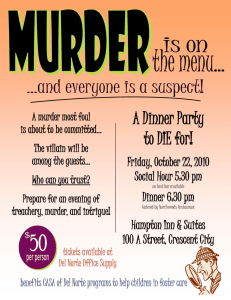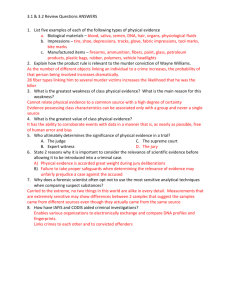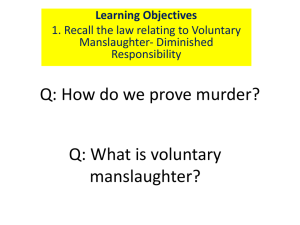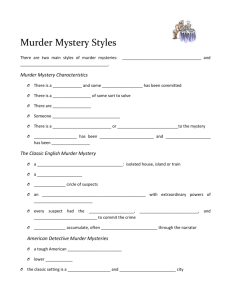Murder
advertisement
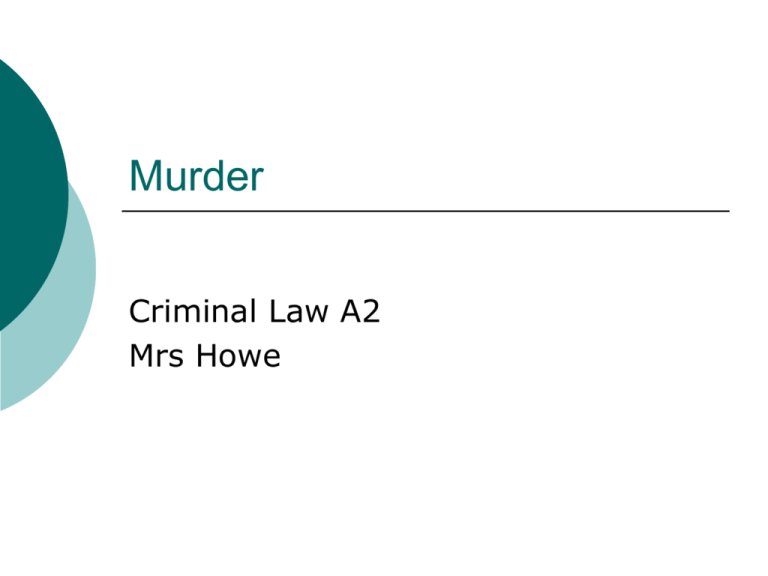
Murder Criminal Law A2 Mrs Howe What is murder? The Actus Reus for Murder is An unlawful act which causes the death of a human being in the Queens peace and within a country of the realm. Unlawful Act Unlawful Act- an action which causes the death of another Can be one of many things including: Scaring someone to death Someone who is killed trying to escape an attacker Death Death- due to advances in medical science people can be kept alive along time. Courts consider death to be brain stem death. Malcherak 1981 What is a Human Being For purposes of legal proceedings the following are not human beings: Foetus is not a human being. R v Copeland 1999 A person in a vegetative coma kept alive by life support machine A person who is in hospital in a brain dead state, kept alive by machines Brain stem death is taken as the key indicator. Once this occurs no chance of recovery Queens Peace Queens peace- if a soldier kills someone in the line of duty and war has been declared with that country, not murder. R V Clegg 1995 Do you think this is right? Activity Read pg 74 Do you think Sgt Clegg should have been convicted of murder, manslaughter or neither Give reasons for your answer 10 mins Country of the Realm Country of the Realm- If a British person commits murder they can be brought back to UK to be tried for murder Mens Rea of MurderThe intention to kill another human being. Two possible elements presence of either is enough to prove murder 1. Intention to kill (express malice aforethought) 2. Intention to cause grievous bodily harm (implied malice aforethought) Implied malice for a successful murder conviction prosecution only have to prove GBH was intended and death resulted. DO not have to prove intention to murder Express malice if intention to kill can be proved then this is known as expressed malice Intention Two types Direct Intention- D clearly desired the outcome and was happy when it was accomplished. Was D’s aim Oblique Intention- D kills someone else rather than/as well as the person he intended to kill This causes a problem for the court as D may not have necessary Mens Rea for murder. R V Nedrick 1986 R V Woolin 1998 Nedrick 1986 Defendant poured petrol through the letterbox of a house to frighten the women living there. The result was the death of a child. 2 questions arose with regard to intent 1. was the result a virtual certainty of the action? 2.Did the D realise that the result would be a virtual certainty of his action Unless jury was happy that the answer to both questions was yes they should not assume the D intention Woollin 1998 A D threw his three month old baby at his pram. The baby missed the pram and crashed into the wall, dying of his injuries. The courts were not happy with the 2 questions used in Nedrick case but still wanted the jury to find intention but only if they thought the result was a virtual certainty from the actions of the D and that they knew this to be the case. Evidence of Intention Can be seen in Foresight of consequences. Does the D realise that their actions will cause a particular event even if they do not want that to happen. R V Stephenson 1979 In the absence of Mens Rea the D may still be charged with involuntary manslaughter. Cannot be charged with manslaughter as would need some element of mens rea to be present. Activity What is the difference between “Virtual Certainty” and “Substantial Risk”? Why did Woolin refer the judges direction of “virtual Certainty”? 10mins Sentencing -Mandatory Sentences Only sentence available for Murder is Life imprisonment. Life means for the life of the D. However some of that sentence can be carried out on licence. Judge has some discretion/flexibility on the maximum tariffs. Sentence will be higher if: It is a professional killing Is racially motivated Is politically motivated Involve vulnerable people (old people, children etc) Minimum sentence to be served will be lower if: It’s a mercy killing A borderline manslaughter case Over reaction due to self defence There was a mental disorder (falls short of diminished responsibility) Practice statement also says that it is highly unlikely that D will be released when the minimum term is served Chain Of Causation Often D tries to rely on the fact there has been medical intervention which caused the death of V or broke the Chain of causation. Courts wary to accept this. Only the most unusual medical treatment would break the chain. R V Smith 1959 R V Cheshire 1991 R V McKechnie 1991 Courts can choose which test to apply in each case. D can still be guilty of murder where the V refuses or fails to get medical help. Blaue 1975 Courts will apply But for test Defences to Murder Provocation- only a defence for murder Diminished responsibility Defendant has abnormality of mind Inherent cause Abnormality of mind caused by disease Abnormality of mind caused by injury Retarded development of the mind Suicide Pact Provocation “A sudden temporary loss of self control, rendering the accused so subject to passion as to make him or her for the moment not the master of his mind” R V Duffy 1949 If proven provocation will reduce charge to manslaughter. Problem where D does not fly into a rage, Favours men Where there is premeditation/an act which shows consideration of murder there can not be provocation The longer there is a delay between abuse and action more unlikely provocation would succeed as a defence R V Ahluwalia 1992R V Ibrams and Gregory 1981- planning shows revenge Duffy has been used successfully in all these cases issue for court to decide. Jury to decide if provocation, S3 of homicide Act 1957 Examples of Provocation Crying babies References to lack of sexual ability Accusations of homosexuality Adultery Physical assaults Long-term mental abuse Question Why is it important to the D not to be charged with murder? R V Sara Thornton 1992 D was convicted for murder in 1992. Her husband Malcolm had physically and mentally abused her for many years and one night she sharpened a knife from the kitchen and the stabbed him to death after he had once more threatened her. She was found guilty of murder because of the absence of sudden loss of control. The premeditated sharpening of the knife was seen as a significant event R V Ahluwalia 1992 D had been the long term victim of an abusive husband and one night she set her husbands bed alight after covering it with petrol. The man died 6 days later. D was convicted of murder despite arguing that Duffy was an inappropriate test to be used in her case. In other words Duffy test of rage not applicable as she is female but the abuse she had suffered cld still be considered as provocation. The longer the delay between???? R V Ibrams and Gregory 1981 a couple had been imtimadated by the womans ex boyfriend, John Monk an dthey hatched a plan, along with a friend to deal with him. The plan involved him being persuaded to go to bed with the woman and then to be attacked by the D’s. Monk died during the attack. Ct felt that the planning and time difference between the killing and the last threatening actions by Monk invalidated their defence of provocation Provocation There is a subjective and objective element to defence of provocation Subjective – what happened to the defendant. Objective- what would reasonable man have done. Must be certain that provocation would have made reasonable man act in the same way. Reasonable can share some are all characteristics of the D DPP V Camplin 1978 DPP V Camplin 1978 15 year old boy who had been sexually abused by an older man. The older man laughed at D who then hit him over the head with a heavy cooking pan. The man was killed. In this case the House of Lords defined reasonable man as one who shared some of the characteristics of the D, that is gender, age and sexuality. Diminished responsibility S2 homicide act 1957 If a person kills while suffering such an abnormality of mind as substantially impaired his mental responsibility for the acts or omissions. Three Legal Elements: The D has abnormality of mind The abnormality is related to specific causes The abnormality impairs mental responsibility Three Characteristics Can only be used as defence against murder Only reduces charge to manslaughter Premeditation does not rule out diminished responsibility Diminished Responsibility If proven judge has discretion with the sentencing. Nothing to life or committal to hospital under Mental Health Act 1983 Jury decide if abnormality of mind Both sides present medical evidence Sometimes jury have sympathy with D- not Peter Sutcliffe Activity Was the jury right to refuse Sutcliffe's plea of diminished responsibility? Give reasons for you answer 5 mins Homework Read the handout Read Pg’s 67-75
